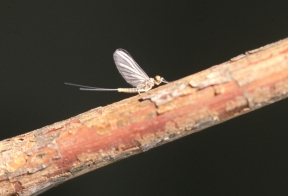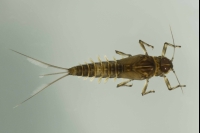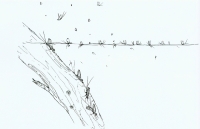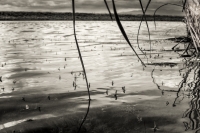
The Fly

Blue Wing Olives are the first mayflies we see in East Idaho. While there are just a few being seen here and there, stay tuned for the next couple of weeks. As water temps come up seeing these hardy mayflies in good numbers is right around the corner. Blue Wings or Baetis can be found throughout the west in most tailwaters and spring creeks. They can tolerate lower water temps and are multi-brooded, meaning they will have two or more broods in a year. Mike Lawson’s book Spring Creeks goes into greater detail about these insects. The bottom line here is that these small mayflies are able to survive the harshest conditions that the East Idaho spring and late fall can throw at them. I have been on Harriman late in the season when anybody with good sense is at home. With the wind howling and snowing sideways, these small mayflies are still coming off in great numbers. It’s as if they prefer bad weather to hatch!
Life Cycle

Baetis nymphs are very streamlined and are great swimmers. Turn a rock over in the river this time of the year and they are easy to identify. They will swim to the bottom heading for cover. They are dark brown or to almost black in color. They have two tails and are in the #18 to #22 size range. When water temps are right the nymphs are buoyed to the surface where they emerge. This time of the year the duns are vulnerable as they will float on the surface for a longer period in order for their wings to dry. Also keep in mind the emergence is most likely to occur mid-day when the outside temps are the warmest. After the magic happens the females will head into the bushes for a period as the eggs ripen. What happens next is amazing to me. The females deposit the eggs by crawling or diving back into the water. Males will often follow. After the eggs have been deposited the spinners die.
Fishing Techniques

As with midge fishing don’t panic if you don’t see rising fish when you arrive. The hatch will occur at some point during the day. Look in the same water you would for midge activity. Look for slow moving water where trout don’t have to work hard. Start your day nymphing. Small sparsely tied patterns will work very well. The Cocktail Nymph is one of my favorites. I will often fish two nymphs. A #16 Olive Zebra Midge with a #18 Cocktail Nymph. The key is to get them down. I sometimes use a split shot in between my two nymphs to accomplish this. The size of the split shot is determined by the depth and speed of the current. I find that a #4 split shot will usually do the trick. Once the hatch begins you can keep it simple. A #18 Lawson’s Nohackle will do the trick 9 out of 10 times. As always it never hurts to have a variety of spinners and emergers. I think the key is to have these other patterns in #16 through #20s. The Harrop CDC Emerger #20, Lawson’s Nohackle #18 and #20 and Cocktail Nymph #18 and #20. I also like Sawyer’s Pheasant Tail #18 and #20. I think you’re fine using Rio’s Power Flex Leaders in a 5X and having some 6X tippet is not a bad idea for the smaller sizes. For nymphing I also like to use smaller indicators like the air lock ½ inch works well and is easy to adjust.